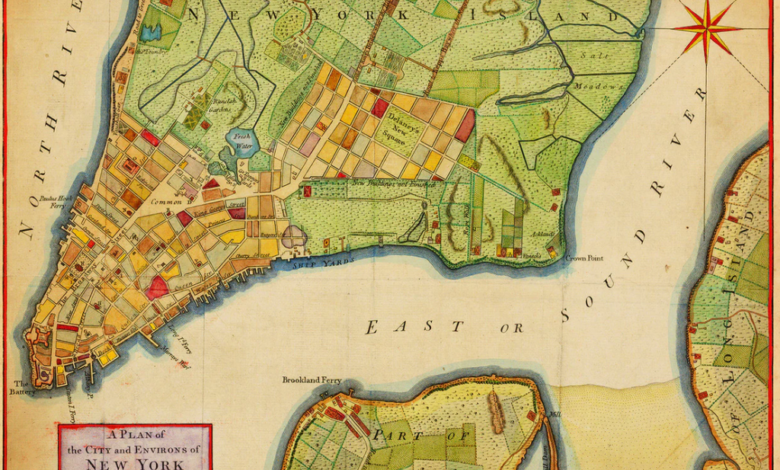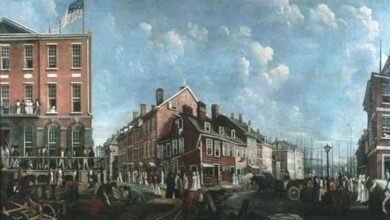Remembering the British Prison Ship Martyrs of New York City


 About 11,500 Americans lost their lives aboard British prison ships from 1776 to 1783. More soldiers, sailors and civilians died aboard the prison ships than in all of the Revolutionary War battles combined. It started with the Battle of Brooklyn (the Battle of Long Island).
About 11,500 Americans lost their lives aboard British prison ships from 1776 to 1783. More soldiers, sailors and civilians died aboard the prison ships than in all of the Revolutionary War battles combined. It started with the Battle of Brooklyn (the Battle of Long Island).
The City of New York played an important role throughout the American Revolution. Not only was the city an important port of commerce, providing supplies and food to the Continental Army, but it served as a central communications route between the northern and southern states.
Without a large naval military, the Continental Army used privately owned ships to advance the patriotic cause, carrying supplies and messages from Boston to New York and down to the southern colonies.

 New York’s importance as a strategic location during the American Revolution was not lost on either the British or the American patriots and would become the location of the first military engagement following the signing of the Declaration of Independence.
New York’s importance as a strategic location during the American Revolution was not lost on either the British or the American patriots and would become the location of the first military engagement following the signing of the Declaration of Independence.
On August 27, 1776, just eight weeks after the colonies declared their independence from England, the Battle of Brooklyn began.
The battle was the largest of the American Revolution with more than 30,000 British troops outnumbering George Washington’s 10,000 troops, resulting in a British victory and subsequent occupation of the City of New York for the remainder of the war.
Although George Washington and his army were able to retreat and escape capture, an estimated 1,300 prisoners of war would remain in British custody. Continental soldiers only comprised a portion of the prisoners held captive by the British during the American Revolution however.
Civilians and privateers commissioned by the Continental Army who refused to pledge allegiance to the Crown of England were also arrested and held in New York’s two jails.

 The number of prisoners held captive by the British quickly outgrew the jails, leading the British to use abandoned churches, warehouses, and ultimately decommissioned war ships known as “hulks” anchored off the Brooklyn coast.
The number of prisoners held captive by the British quickly outgrew the jails, leading the British to use abandoned churches, warehouses, and ultimately decommissioned war ships known as “hulks” anchored off the Brooklyn coast.
During the war, at least 16 hulks, including the infamous HMS Jersey (a former warship built in 1736 and converted to a hospital ship before becoming a prison hulk), were placed by British authorities in the waters of Wallabout Bay.
Living conditions in the British prisons were unbearable, but none as much as on the prison ships. The ships were overcrowded; the prisoners were tortured; and, if fed, prisoners were given rancid food and unclean water.
In 1778, Robert Sheffield, one of 350 prisoners held in a compartment below the decks, escaped and told his story in the Connecticut Gazette:
“The heat was so intense that (the hot sun shining all day on deck) they were all naked, which also served well to get rid of vermin, but the sick were eaten up alive.
“Their sickly countenances, and ghastly looks were truly horrible; some swearing and blaspheming; others crying, praying, and wringing their hands; and stalking about like ghosts; others delirious, raving and storming, — all panting for breath; some dead, and corrupting [decomposing].
“The air was so foul that at times a lamp could not be kept burning, because of which the bodies were not missed until they had been dead ten days.”
Diseases, including smallpox and yellow fever, ran rampant on the ships. Captives on the ships died from malnutrition and disease at alarming rates of 10-12 prisoners a day. Their bodies were either thrown overboard or buried in shallow graves along the banks of the bay.

 Historian Edwin G. Burrows writes that “by the end of 1776, disease and starvation had killed at least half of those taken on Long Island and perhaps two-thirds of those captured at Fort Washington – somewhere between 2,000 and 2,500 men in the space of two months.”
Historian Edwin G. Burrows writes that “by the end of 1776, disease and starvation had killed at least half of those taken on Long Island and perhaps two-thirds of those captured at Fort Washington – somewhere between 2,000 and 2,500 men in the space of two months.”
Christopher Vail, who was held aboard HMS Jersey five years later in 1781, wrote:
“When a man died he was carried up on the forecastle and laid there until the next morning at 8 o’clock when they were all lowered down the ship sides by a rope round them in the same manner as tho’ they were beasts.
“There was 8 died of a day while I was there. They were carried on shore in heaps and hove out the boat on the wharf, then taken across a hand barrow, carried to the edge of the bank, where a hole was dug 1 or 2 feet deep and all hove in together.”
The prison ships held captives until 1783 when the British occupation of New York ended. It is estimated that approximately 11,500 soldiers, sailors, and civilians lost their lives aboard the prison ships from 1776 to 1783. More Americans died aboard the prison ships than in all of the Revolutionary War battles combined.
In the years following the war, the bodies of the prison ship martyrs would wash up on the shores of Brooklyn. Remains were collected and held in a small crypt near what is now the Brooklyn Navy Yard.
In 1808 that burial vault collapsed and the remains of those that died aboard the prison ships were re-interred in Fort Greene Park, on which a part of the Battle of Long Island had been fought.
A monument to memorialize the martyrs was created, but by the mid-1800s, the monument had fallen into disrepair and plans for a new monument to be located in the newly created Washington Park (now Fort Greene Park) were conceived.

 The Prison Ship Martyrs Memorial
The Prison Ship Martyrs Memorial
In 1867, Frederick Law Olmsted and Calvert Vaux were hired to create a new design for what would become Fort Greene Park. At the insistence of The Martyrs’ Memorial Association, the large city park was to include a burial site and permanent monument for the remains of the prison ship martyrs.
Olmsted and Vaux’s design included a large crypt and elaborate memorial set into the stepped hillside in the northwest corner of the park.
The park entrance on the intersection of Canton Street and Myrtle Avenue opened onto a large public gathering space designed for public meetings and political speeches. From the open space, a tiered staircase would lead up the steep hillside to a saluting battery, refreshment house, observatory, and a set of open playing fields.
The design also included an elaborate monument for the prison ship martyrs halfway up the grand staircase with a crypt being located beneath the monument.
Construction on the Olmsted and Vaux plans began in 1868, but an economic downturn caused the Olmsted and Vaux’s elaborate plans to be cut short.
The open space and tiered staircase would be completed, along with a vault for the remains of the martyrs, but the monument itself and the observatory were never created. In 1873, 22 boxes containing the remains of the prisoners were interred into the vault.
In 1899, construction of new facilities at the Brooklyn Navy Yard uncovered additional remains and sparked new interest in creating a more significant monument to the prison ship martyrs and a new campaign for funding was initiated.
On June 30, 1902, Congress passed an act (32 Stat. 747) that provided $100,000 towards designing and constructing a large commemorative structure in Fort Greene Park to memorialize the martyrs. The act provided specifically that the contribution of the federal government was contingent upon the raising of a like sum by private subscription and by the State and City of New York.
In 1905, the architectural firm of McKim, Mead, and White was hired to design a new entrance to the existing vault and a permanent monument to the prison ship martyrs.

 The McKim, Mead, and White design transformed the existing grand staircase into a 100-foot wide staircase broken into three flights. The entrance to the crypt, located in the center of the middle flight of stairs, is a single bronze door. At the top of the staircase sits a large plaza with four bronze eagles set at each of the four corners.
The McKim, Mead, and White design transformed the existing grand staircase into a 100-foot wide staircase broken into three flights. The entrance to the crypt, located in the center of the middle flight of stairs, is a single bronze door. At the top of the staircase sits a large plaza with four bronze eagles set at each of the four corners.
The Prison Ship Martyrs’ Monument, a 149-foot Doric column, is centered on the plaza on top of a two-tiered square base. The base of the column includes two bronze doors, identical to the crypt door and the column is topped with a 22-foot bronze lantern designed by Adolph Alexander Weinman (who also designed the plaza’s four eagles).
The McKim, Mead, and White design also modified several other areas of the original Olmsted and Vaux plan including the addition of a small comfort station to the north of the upper plaza and a redesign of the lower plaza (which was never fully implemented).
The McKim, Mead, and White Prison Ship Martyrs’ Monument was completed and dedicated in a ceremony attended by President-elect William H. Taft in 1908.
Since the dedication ceremony, the Monument, grand staircase, and upper and lower plazas have been modified. Some alterations to the Monument, such as the construction of an interior elevator, were subsequently removed.
The upper and lower plazas have been modified twice since 1908: once in 1936 with a design by Gilmore Clarke, and the second through a 1972 design by A. E. Bye.
The upper plaza was expanded, branching out to the north and south, while the lower plaza was transformed to include a set of smaller open spaces including playgrounds, a comfort station, and seating areas.
The grand stair case retains its McKim, Mead, and White three-tiered layout, but has been modified with tree wells and planting beds. The underground crypt remains in its original location.

 “Not of National Significance” Finding
“Not of National Significance” Finding
In 2021, after a study and analysis of the Prison Ship Martyrs’ Memorial in order to have the site named a National Historic Landmark, the National Park Service determined that the site “does not meet the criteria for national significance for cultural resources through the application of national historic landmark criteria.”
NPS argued that while the monument is indirectly associated with a historic event, it did not exist during the time of the historic event and it memorializes a phase of history not associated with the site.
The criteria for National Park Service designation requires that sites not only have historical or cultural significance, but also a high degree of integrity of location, design, and setting.
Cemeteries and other properties that are commemorative of events unrelated to their sites, such as the Prison Ship Martyrs’ Monument, do not ordinarily qualify for designation.
NPS also determined that the Memorial did not possess national significance based on its own architectural or design values because it does not represent an exceptionally important design of either Olmsted and Vaux or McKim, Mead and White.
Visiting Fort Greene Park and the Prison Ship Martyrs’ Monument
Fort Greene Park and the Prison Ship Martyrs’ Monument are owned and operated by the New York City Department of Parks and Recreation. The park is open daily from 6:00 a.m. to 1:00 a.m. unless otherwise posted.
A staffed visitor center is located to the north of the Prison Ship Martyrs’ Monument and includes an exhibit on the prison ship martyrs’ and the history of Fort Greene Park within the context of the Revolutionary War. Restrooms are located within the visitor center and in a small comfort station on the lower plaza. Neither the Monument nor the crypt are open for public access.
New York Almanack shares serious, but approachable history. Please support this work.
Illustrations, from above: a map of Manhattan in 1776 (see a larger version here); The Delaware Regiment at the Battle of Long Island by 21st century artist Domenick D’Andrea, created for the National Guard Bureau; The Middle Dutch Church in New York City near Nassau and Cedar Streets, ca. 1830, whereenlisted men captured at the Battle of Long Island were imprisoned. The Sugar House next door also became a prison for thousands as the British captured more of Washington’s troops from Fort Washington and other engagements during the retreat from New York; today this is the location of One Chase Manhattan Plaza; The prison ship HMS Jersey moored at Wallabout Bay in 1782; 1867 Olmsted & Vaux Plan, then known as Washington Park; The 1908 unveiling and dedication of the Prison Ships Martyrs Monument; the Prison Ship Martyrs’ Monument in 2024.
Source link




